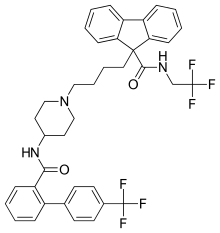Lomitapide
Lomitapide (INN, marketed as Juxtapid in the US and as Lojuxta in the EU) is a drug used as a lipid-lowering agent for the treatment of familial hypercholesterolemia, developed by Aegerion Pharmaceuticals.[1] It has been tested in clinical trials as single treatment and in combinations with atorvastatin, ezetimibe and fenofibrate.[2][3]
 | |
| Clinical data | |
|---|---|
| Trade names | Juxtapid (US), Lojuxta (EU) |
| Other names | AEGR-773, BMS-201038 |
| License data |
|
| Pregnancy category |
|
| Routes of administration | Oral (capsules) |
| ATC code | |
| Legal status | |
| Legal status |
|
| Identifiers | |
IUPAC name
| |
| CAS Number |
|
| PubChem CID | |
| IUPHAR/BPS | |
| ChemSpider | |
| UNII | |
| KEGG | |
| ChEBI | |
| CompTox Dashboard (EPA) | |
| Chemical and physical data | |
| Formula | C39H37F6N3O2 |
| Molar mass | 693.719 g/mol g·mol−1 |
| 3D model (JSmol) | |
SMILES
| |
InChI
| |
| | |
The US Food and Drug Administration (FDA) approved lomitapide on 21 December 2012, as an orphan drug to reduce LDL cholesterol, total cholesterol, apolipoprotein B, and non-high-density lipoprotein (non-HDL) cholesterol in patients with homozygous familial hypercholesterolemia (HoFH).[4]
On 31 May 2013 the European Committee for Medicinal Products for Human Use (CHMP) adopted a positive opinion with a unanimous vote recommending a marketing authorization for lomitapide.[5] On 31 July 2013 the European Commission approved lomitapide as an adjunct to a low-fat diet and other lipid-lowering medicinal products with or without low density lipoprotein (LDL) apheresis in adult patients with HoFH.
Mechanism of action
Lomitapide inhibits the microsomal triglyceride transfer protein (MTP or MTTP) which is necessary for very low-density lipoprotein (VLDL) assembly and secretion in the liver.[1][6]
On 24 December 2012, drug manufacturer Aegerion announced they had been approved by the FDA to as "an adjunct to a low-fat diet and other lipid-lowering treatments...in patients with homozygous familial hypercholesterolemia (HoFH)."[7][8]
Side effects
In a Phase III study, lomitapide led to elevated aminotransferase levels and fat accumulation in the liver.[6]
References
- H. Spreitzer (12 March 2007). "Neue Wirkstoffe – BMS-201038". Österreichische Apothekerzeitung (in German) (6/2007): 268.
- Samaha, Frederick F; James McKenney; LeAnne T Bloedon; William J Sasiela; Daniel J Rader (2008). "Impact of the MTP-Inhibitor, AEGR-733, as Monotherapy and in Combination with Ezetimibe on Lipid Subfractions as Measured by NMR Spectroscopy". Circulation. 118 (5): 469–71. doi:10.1161/CIRCULATIONAHA.108.792689. PMID 18663098.
- Aegerion Pharmaceuticals, Inc. Announces AEGR-733 Phase II Data Demonstrates Significant Lowering of LDL Cholesterol with Promising Hepatic Safety Profile Archived 2012-02-29 at the Wayback Machine
- "FDA approves new orphan drug for rare cholesterol disorder"
- European Medicines Agency: Lojuxta
- Cuchel, M.; Bloedon, L. T.; Szapary, P. O.; Kolansky, D. M.; Wolfe, M. L.; Sarkis, A.; Millar, J. S.; Ikewaki, K.; Siegelman, E. S.; Gregg, R. E.; Rader, D. J. (2007). "Inhibition of Microsomal Triglyceride Transfer Protein in Familial Hypercholesterolemia". New England Journal of Medicine. 356 (2): 148–156. doi:10.1056/NEJMoa061189. PMID 17215532.
- "FDA Approves Juxtapid for Homozygous Familial Hypercholesteolemia". 26 December 2012.
- "FDA Approves Aegerion Pharmaceuticals' Juxtapid (lomitapide) Capsules for Homozygous Familial Hypercholesterolemia (HoFH)" (Press release). Aegerion Pharmaceuticals. 24 December 2012.